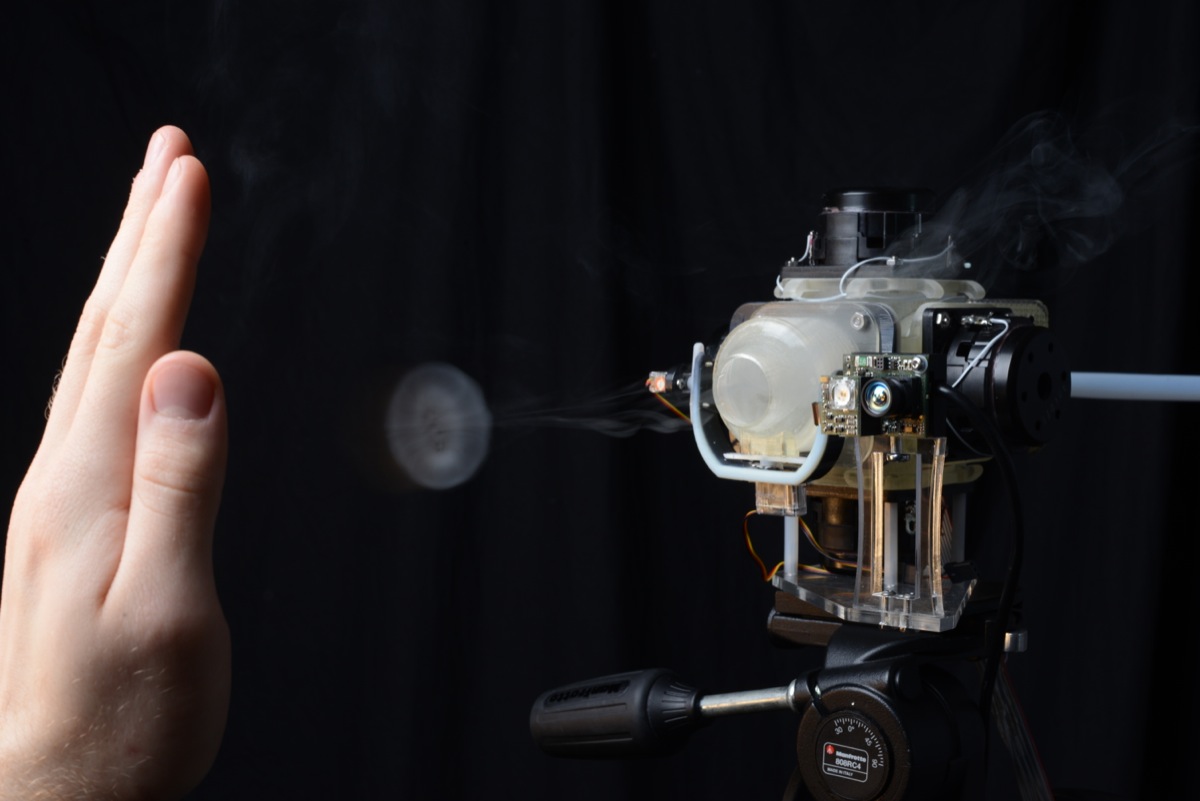Project #1: Aireal (2013)
Created by Disney Research Group: Rajinder Sodhi, Ivan Poupyrev, Matthew Glisson and Ali Israr.Demonstrated @ SIGGRAPH 2013
Haptic display, Human-Computer Interaction
2. Technology
New low cost, highly scalable haptic technology, 3D print
3. Interaction
Aireal enables users to feel digital objects through a tactile experience in the air. It emits a series of rings of air called "vortexes" to hit the user's skin. It provides effective tactile feedback with a 75 degrees field of view, and within an 8.5 cm resolution at 1 meter [Sodhi, 2013].
4. Design
Aireal uses a 3D printed enclosure, a flexible nozzle, pan and tilt motors, whisper subwoofers and a 3D depth camera. The enclosure is the main structure to hold all parts together. The flexible nozzle and motors enables Aireal to emit vortexes precisely in 3D space. Each Aireal device is manually instrumented with calibration infrared markers and the depth camera is used to detect these markers to find 3D correspondences with locations on the Aireal's 3D known model.
5. Value
In my opinion, Aireal presents a novel method to create tactile feedback for digital information within the field of HCI. Traditionally, we are used to design haptic devices on body (e.g. wearable devices). Conversely, natural interactions encourage people to access virtual objects without wearing any devices on body. I think Aireal not only contributes in inventing new haptic technology, but also inspires makers and HCIers to look back at those basic principles of interaction. Also ,this kind of tactile feedback can be applied in various fields: video gaming, web surfing, collaborating work, and etc.
Reference: Sodhi R, Poupyrev I, Glisson M, et al. AIREAL: interactive tactile experiences in free air[J]. ACM Transactions on Graphics (TOG), 2013, 32(4): 134.
Project #2: Tactilu (2013)
1. Fields (Disciplines):
Design, Wearable computing, Tactile, Human-Computer Interaction
2. Technology
Bluetooth, muscle wire, QTC, Arduino, Android
3. Interaction
Tactilu is a bracelet-like device supporting remote tactile communication. Two individuals can wear a pair of Tactilu to send and receive the touch via wireless connectivity. On the upper side of the bracelet the sending device coverts swipes into tactile motion on the receiving device. With the help of muscle wires, the receiving device can simulate the touch in realtime.
4. Design
Tactilu is a research project, powered by custom Arduino pro mini, custom pcb with bluetooth module, custom pcb with QTC ( quantum tunneling composite ) sensors, custom pcb controlling five flexinol wire actuators, li-poly battery with current controller / charger and a custom 3d printed enclosure. Software is comprised of Arduino / C for controlling hardware and communication via bluetooth, Java / Android SDK for app running on the smartphone and server for sending touch signals via internet.
5. Value
Tactilu is a tangible interactive device caring about emotional communication between individuals. Obviously, it has some values in applying new technology in art and design. Besides advanced technology, I think it addresses human nature of making things interactive. It is simple but warm for human beings' emotion expression and communication.
Source: http://pangenerator.com/#projects/project-tactilu
Source: http://pangenerator.com/#projects/project-tactilu
Project #3: Eidos (2013)
Created by Tim Bouckley, Millie Clive-Smith, Mi Eun Kim, and Yuta Sugawara.
Design, AR, Human-Computer Interaction, Fabrication
2. Technology
Camera, Microphone, Sensors, 3D print, CV, Prototyping
3. Interaction
Eidos has two parts: sight mask and audio mask. When the user wears the sight mask, Eidos captures the scene the user sees and returns information with enhancements, detecting patterns of movement. When the user wear the audio mask, Eidos cancels all noises except the one you want to hear.
4. Design
A camera is embedded in the sight mask to capture what the user sees. To display the picture that augments the real scene, two screens and projectors are set for eyes in the mask. As for the audio mask, three channels are set for audio: left, right and central mouth piece, which helps the user hear the voice right in his/her head.
5. Value
Eidos is a design about how to control our sense in sight and hearing. It attempts to explore human being's capability to control senses, which is valuable in guiding us to make things interactive. Since most things are static but we have dynamical ability to sense the world around us, we could take advantages of this situation when we design, make and fabricate things. In addition, the whole design process is also a good example for making things. The makers of Eidos conducted iterated design and prototype to decide what technology and form are the most suitable in their project, eventually for their goals.
Source: http://www.timbouckley.com/work/design/eidos.php
Source: http://www.timbouckley.com/work/design/eidos.php















No comments:
Post a Comment